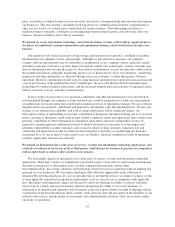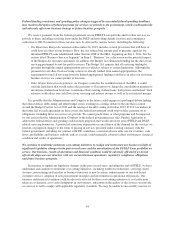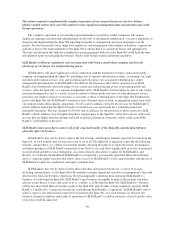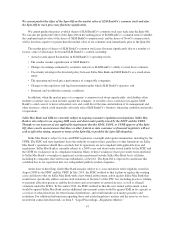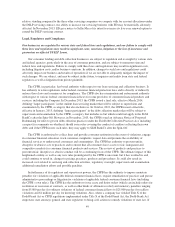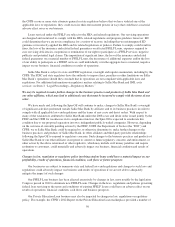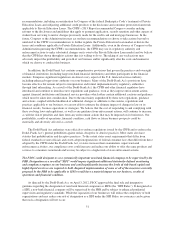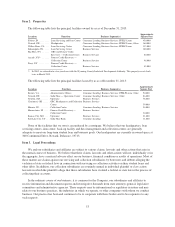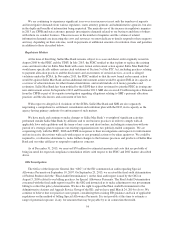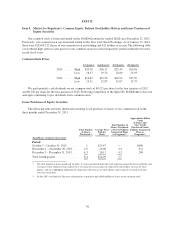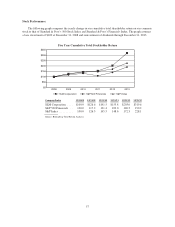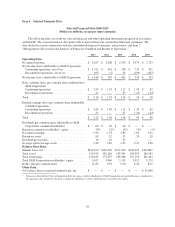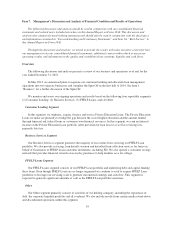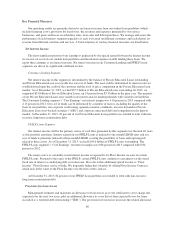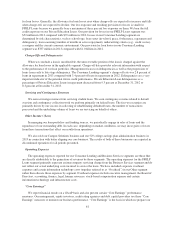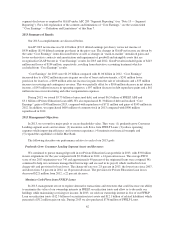Sallie Mae 2013 Annual Report Download - page 54
Download and view the complete annual report
Please find page 54 of the 2013 Sallie Mae annual report below. You can navigate through the pages in the report by either clicking on the pages listed below, or by using the keyword search tool below to find specific information within the annual report.The revised capital requirements under the U.S. Basel III capital rules impose heightened capital standards
which may adversely affect us, our business, results of operations and financial position.
In July 2013, the federal banking regulators issued the U.S. Basel III final rule. The final rule implements
the Basel III capital framework in the United States and certain provisions of the Dodd-Frank Act, including the
Collins Amendment. The U.S. Basel III final rule will apply to Sallie Mae Bank beginning on January 1, 2015.
Consistent with the Basel Committee on Banking Supervision’s Basel III capital framework, the U.S. Basel III
final rule includes a new minimum ratio of Common Equity Tier 1 capital to risk-weighted assets of 4.5 percent
and a Common Equity Tier 1 capital conservation buffer of greater than 2.5 percent of risk-weighted assets that
will apply to all U.S. banking organizations, including Sallie Mae Bank. Failure to maintain the capital
conservation buffer will result in increasingly stringent restrictions on a banking organization’s ability to make
dividend payments and other capital distributions and pay discretionary bonuses to executive officers. The capital
conservation buffer and certain other aspects of the U.S. Basel III final rule will be phased in over several years.
The final rule also increases the minimum ratio of Tier 1 capital to risk-weighted assets from 4 percent to
6 percent, while maintaining the current minimum total risk-based capital ratio of 8 percent. Sallie Mae Bank
will also be subject to increased leverage capital requirements as its leverage ratio, Tier 1 capital to average total
consolidated assets (minus amounts deducted from Tier 1 capital), must be at least 4 percent. Effective January 1,
2015, the final rule revises the capital categories, including the well-capitalized category, in the prompt
corrective action framework applicable to insured depository institutions such as Sallie Mae Bank to reflect the
higher Basel III capital ratios. If Sallie Mae Bank fails to satisfy regulatory capital or leverage capital
requirements, it may be subject to serious regulatory sanctions which could also have an impact on us. If any of
these sanctions were to occur, they could prevent us from successfully executing our business plan and may have
a material adverse effect on our business, results of operations, and financial position.
Our ability to continue to grow our businesses related to contracting with state and federal governments is
partly reliant on our ability to remain compliant with the laws and regulations applicable to those contracts.
We are subject to a variety of laws and regulations related to our government contracting businesses,
including our contracts with ED. In addition, these government contracts are subject to termination rights, audits
and investigations. If we were found in noncompliance with the contract provisions or applicable laws or
regulations, or the government exercised its termination or other rights for that or other reasons, our reputation
could be negatively affected, and our ability to compete for new contracts could be diminished. If this were to
occur, the future prospects, revenues and results of operations of this portion of our business could be negatively
affected.
Our framework for managing risks may not be effective in mitigating our risk of loss.
Our risk management framework seeks to mitigate risk and appropriately balance risk and return. We have
established processes and procedures intended to identify, measure, monitor, control and report the types of risk
to which we are subject. We seek to monitor and control our risk exposure through a framework of policies,
procedures, limits and reporting requirements. Management of risks in some cases depends upon the use of
analytical and/or forecasting models. If the models that we use to mitigate these risks are inadequate, we may
incur increased losses. In addition, there may be risks that exist, or that develop in the future, that we have not
appropriately anticipated, identified or mitigated. If our risk management framework does not effectively identify
or mitigate our risks, we could suffer unexpected losses and our financial condition and results of operations
could be materially adversely affected.
Item 1B. Unresolved Staff Comments
None.
52



